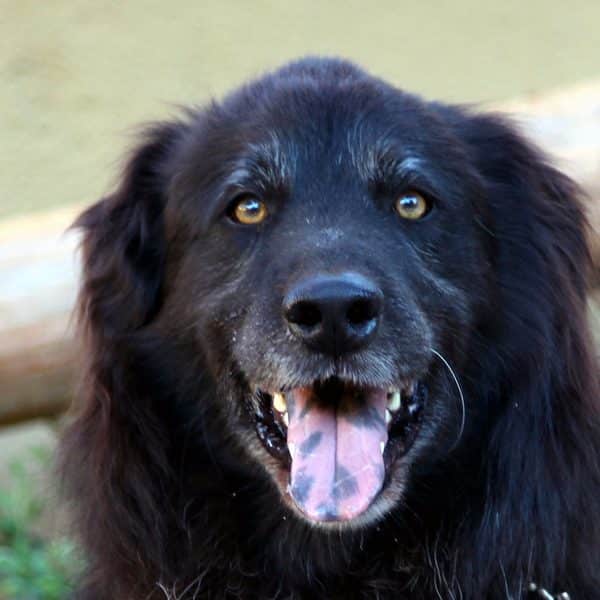Dog tongues are endlessly intriguing! Dogs use their tongues for everything from the obvious — eating and drinking — to grooming, communicating, controlling body temperature, and investigating environments. These fleshy, slobbery, tentacle-like organs are critically important to almost everything a dog does. One thing most of us don’t pay much attention to is their coloration. Most dogs have pink tongues, just like their owners do, but some dogs have blue, black or even spotted tongues.

There are between 30 and 40 breeds of dog that develop tongue spots. (Photo via Pixabay)
Why do some dogs have spotted tongues? Is it an omen, a portent or a sign that a dog is marked out for some special destiny? No! There are some cases in which tongue discoloration can be a symptom of a medical issue that requires veterinary treatment. We’ll go through these exceptions, along with other, perhaps more alarming signs that you’ll want to watch out for if there’s a sudden change in tongue color. We’re also going to reassure you that, by and large, a parti-colored tongue lolling out of your dog’s mouth is perfectly natural. Our tour through the colors of a dog’s mouth will focus on:
- The Chow Chow and Shar Pei conundrum
- Dogs with spotted or parti-colored tongues
- Melanin and pigmentation
- Tongue discoloration and medical issues in dogs
The Chow Chow and Shar Pei conundrum
All dogs are born with pink tongues, so why do those of Chows and Shar Peis appear in those instantly recognizable darker hues, ranging from purple to blue-black? The phenomenon is similar to color-pointing in cats, or the trademark spotting of Dalmatians’ coats, in that these animals are not born with these patterns or colors, but acquire them after birth. Where Dalmatian spotting begins between 3 and 4 weeks of age, the tongues of Chows and Shar Peis start taking on their full adult coloration between 8 to 10 weeks after they are born.
The major difference between cats and dogs when it comes to acquired color patterns is heat. In cat breeds such as the Siamese, color-pointing, or the high concentration of color in certain areas, is due to a form of inherited partial albinism. These animals’ have less available melanin to begin with, and the pigment enzymes they do have respond strangely to heat. The result is that areas of high-density color in these kinds of cats tend to be at the coolest and most exposed parts of their bodies.

Dark tongue spots are formed by excessive melanin production. (Photo by torbakhopper on Flickr)
As for the tongues of Chow Chows and Shar Peis, melanin production and color distribution are also attributable to traditional breeding programs and resulting genetic anomalies. For these dogs, the anomalies give them excess of pigment, rather than the scarcity that causes color patching in partial albinos. Heat also has no role, either in the dark tongues of Chows and Shar Peis, or in the distribution of Dalmatian spots.
Dog breeds with spotted tongues
Of course, tongue colors beyond basic pink are not exclusive to the Chow and Shar Pei. Unlike the those breeds, the color does not dominate the entire tongue, appearing as random patches over time. Nor are the dark spots limited to the tongue alone. Spotting may be visible wherever there is exposed skin, and can occur anywhere on the body, including a dog’s nose, belly or even the roof of their mouth!
Depending on which source you consult, there are between 30 and 41 dog breeds that may develop black marks, dots or spots on their skin. For the sake of brevity, here are 14 popular breeds known and prone to have spotted tongues:
- Airedale Terrier
- Akita
- Bichon Frise
- Collie
- Cocker Spaniel
- Dalmatian
- Doberman Pinscher
- German Shepherd
- Great Pyrenees
- Labrador Retriever
- Pomeranian
- Pug
- Rottweiler
- Shiba Inu
This abridged list offers a sampling of the full range of spotted tongue dog breeds. Pretty much every kind and body type of dog you can imagine is represented, from tiny lap dogs like the Pomeranian, and brachycephalic dogs like the Pug, to larger, more sporty and athletic breeds. What do these dogs have in common that might explain spots on the tongue in all of them? We know that two breeds have solidly pigmented tongues; is it possible that one of these other dogs has some Chow Chow and Shar Pei in their lineage?

Teddy is an exception: He is a German Shepherd / Chow Chow mix. (Photo by Austin Kirk on Flickr)
Melanin and pigmentation
Anything’s possible, but black marks, dots and spots have been seen even in purebred specimens, so that cannot be the answer in every case. There’s no conspiracy, and your pedigreed dog is highly unlikely to have a checkered family history. There really is no mystery to solve here; these dogs’ melanocytes, the cells that produce melanin, just happen to overproduce it. Once that pigment is there, it tends to gather and concentrate in certain areas, forming these spots.
Tongue spots are a perfectly normal expression of that excess. Spotted tongues, palates and skin are the dog version of freckles or liver spots in humans. These are inexact comparisons, but close enough. The darkest pigment on a dog’s body is seen in their paws, nose, lips and the rims of their eyes. When dark spots begin to form on a dog’s tongue, melanocytes are overproducing that pigment.
Differences between excess color and discoloration
There are several kinds of oral cancer that affect dogs. Each can discolor the tongue and form raised lesions, and each tends to be malignant more often than not. The most prominent, and troublingly, the one that disproportionately affects many of the dogs listed above, is melanoma. Raised, swollen, and discolored bumps in the mouth or feet can appear black, pink or white, as opposed to the flat, dark, blended colors of normal tongue or skin spots. Other symptoms include trouble eating or even tooth loss.

Note that this dog’s spotted tongue is otherwise physically normal. (Photo via Pixabay)
The other major cancer that afflicts dog tongues is squamous cell carcinoma. The growths that occur are usually white, take form very quickly and are accompanied by bleeding. According to Dr. Karen Becker, these tumors account for almost half of all dog tongue cancers. Both melanoma and squamous cell carcinoma can be treated and managed if they are diagnosed early.
Sun’s out, tongues out
It’s important to note that not all tongue color changes in dogs are natural or healthy. The spots and marks we’ve focused on throughout the main part of this article are always dark and flush with the skin. With the exception of their hue, they are indistinguishable from the surface of a dog’s tongue.
Further, the concentrated accumulation of pigment in normal tongue spotting is a gradual process. Dark tongue spots manifest slowly and over time. Caution and care should be the order of the day when color changes or swelling appear suddenly. Make an appointment with your vet if altered color is ever coupled with dramatic shifts in your dog’s weight, energy or ability to engage in normal activities.
The post Why Are There Dogs With Spotted Tongues? appeared first on Dogster.
No comments:
Post a Comment